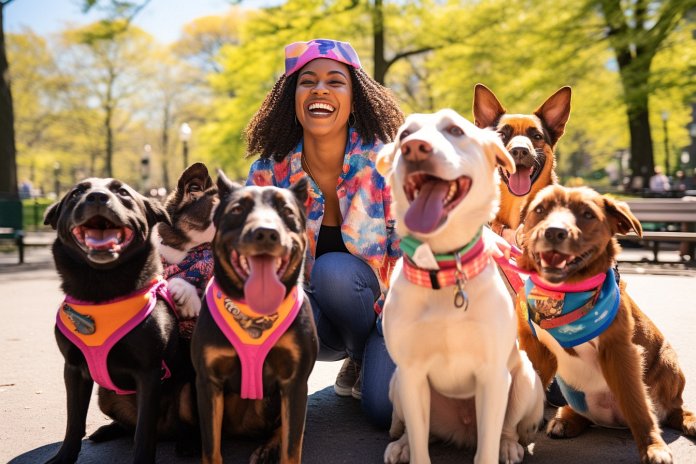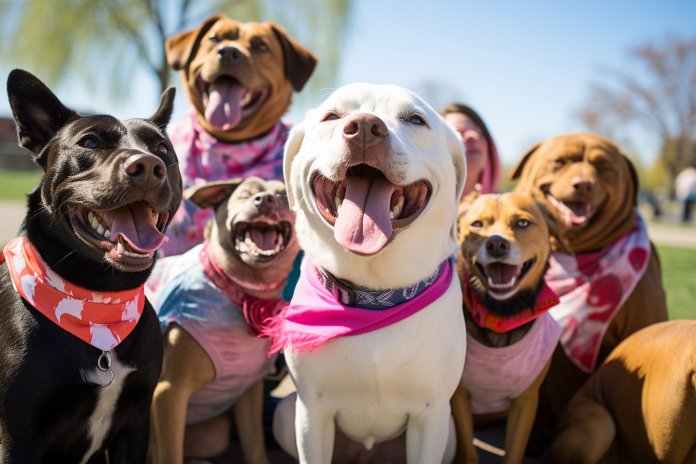
The bond between humans and dogs has developed over centuries. It is traditionally believed that this bond formed for hunting and guarding purposes. However, there is another possibility that scientists may have overlooked. It could be that dogs formed a close relationship with women, who provided warmth and scraps of food in exchange for protection.
Dogs are equally fond of both genders
. Dogs enjoy eating, receiving affection, and being great friends to both men and women. They may be able to differentiate between genders, but it is possible that the gender of their human companion doesn’t really matter to them.
Signs a Dog Can Tell Human Gender
To understand what a dog thinks and feels, we need to pay attention to their body language. About ninety percent of communication, including with humans, is based on posture, eye contact, arousal, and vocalizations. This is also true for dogs. They may not have words, but they can communicate a lot through their behavior and body signals. It is important to observe your dog’s signals, the context of their reaction, and the reactions of others around them to understand what they are thinking.
Dogs have different ways of showing their preferences. When meeting another dog or human, they will typically greet by sniffing the crotch or behind area, where scents are strongest and provide information about mating potential. After the initial sniffing, a dominant dog may stand alert with ears forward, nudging the more submissive dog. The submissive dog will cower, roll over, and expose their stomach. They may also pull their ears back, look to the side, and tuck their tail. It’s best to let dogs complete their greeting rituals without interruption.
Regardless of the gender of their human companion, dogs will show love in various ways. They may cry with joy, run in circles, and give doggy kisses by licking their face. Dogs may also steal their human’s socks and undies to keep their scent close when they are away. They may smile, invite their human to play, and follow them around. Dogs can sense their human’s emotions and will stay by their side when they are sad or not feeling well. Regardless of gender, a positive and loving relationship with a dog will result in a loyal companion.
Body Language
Some signs that a dog may use to determine a person’s gender are:
– Alertness
– Shaking
– Cowering
– Sniffing
– Tail tucking
Other Signs
Additional indications that dogs can discern human genders include:
– Reacting differently to men and women
– Responding to masculine or feminine walks
The History of Dogs Determining Human Genders
The exact origins of the bond between humans and dogs are unknown. However, it is believed that the wolf’s social nature and ability to pick up on social cues played a role in their evolution into dogs. The relationship between humans and dogs has been heavily influenced by men, but dogs relate equally well to women and men when properly socialized. The gender of the alpha in the human family does not matter as long as the human establishes leadership, provides resources, and maintains a positive relationship with the dog. Dogs are equal opportunity pets.
The Science of Dogs Telling Human Gender
Dogs have cognitive abilities that allow them to discern many things and respond to human cues. They may even respond differently to different individuals. Rescue dog owners often notice that their dogs react fearfully to certain genders or characteristics. Scientists have conducted studies to determine if dogs can distinguish between men and women. These studies used visual and auditory cues and found that a dog’s ability to tell gender depends on their exposure to humans of different genders. Dogs living in households with multiple people are more discerning of genders. Ultimately, what matters most is the positive relationship between a dog and their human, regardless of gender, age, or culture.
Training Your Dog to Do Well with All People
Whether you live alone or in a big family, introducing new people into your home can be challenging for your dog. To help your dog adjust to new family members, follow these steps:
1. Designate a specific space for your dog, such as a crate or a dog bed, where they can retreat to.
2. Prepare the new person on how to greet the dog. The person should remain still to allow the dog to sniff them. If the dog tends to jump or has a dominant personality, keep them on a loose leash. Model calm behavior for both the dog and the new person, and then bring the dog to their safe space after the initial greeting.
3. Encourage the new person to give the dog a treat. Instead of feeding the treat by hand, place it in a dish for the dog to take.
4. Plan activities that the new person and the dog can do together, such as going for walks or playing outside.
5. Stay calm, positive, and patient as your dog adjusts to the new family member.
6. If your dog shows aggression towards the newcomer, take it seriously and ensure the safety of all household members. Seek professional help to address aggressive behavior.
“Gender doesn’t matter to a dog when it comes to love and loyalty.”

Tips & Things to Know
1️⃣ Pay attention to your dog’s body language: Dogs communicate their thoughts and feelings through their body language. Observe their posture, eye contact, arousal, and vocalizations to understand their preferences and reactions.
2️⃣ Dogs can recognize different genders: Dogs can distinguish between men and women based on their behavior and body signals. They may react differently to different genders and respond to masculine or feminine walks. However, their ability to recognize gender depends on their social exposure and experience with humans of different genders.
3️⃣ Smoothly introduce new people to your dog: If you have a new person coming into your home, whether male or female, take steps to ensure a smooth adjustment for your dog. Designate a space for your dog, prepare the new person on how to greet the dog, and involve them in positive activities together. Stay calm, positive, and patient during this process and seek professional help if your dog shows aggressive behavior.
Frequently Asked Questions, Answered ✅
1. Can dogs differentiate between men and women based on their behavior?
– Yes, dogs can differentiate between men and women based on their behavior and body language.
2. How do dogs show their preference for a particular gender?
– Dogs show their preference by sniffing, greeting, and reacting differently to men and women. They may also respond to masculine or feminine walks.
3. Is a dog’s ability to determine human gender based on their experience?
– Yes, a dog’s ability to determine human gender is dependent on their social exposure and experience with humans of different genders.
4. Can dogs tell the difference between male and female voices?
– Dogs can tell the difference between male and female voices based on their experience with humans of different genders.
5. How can you train your dog to adjust well to new family members of any gender?
– By designating the dog’s space, preparing the new person on how to greet the dog, offering treats, engaging in fun activities together, staying calm and patient, and seeking professional help if the dog shows aggression towards the newcomer.